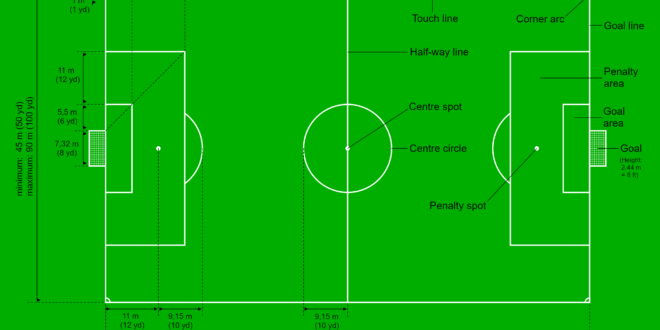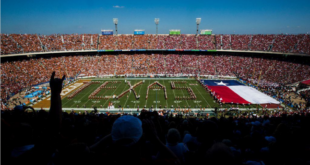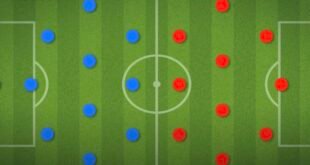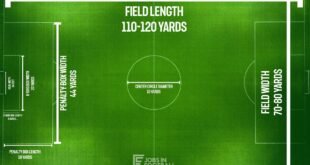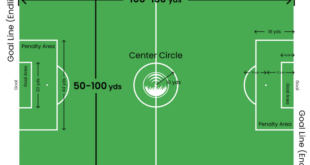A standard soccer field measures between 100 and 130 yards in length and 50 and 100 yards in width. FIFA guidelines suggest optimal dimensions of 110–120 yards long by 70–80 yards wide for professional play.
Soccer, known as football outside North America, is played on a field of varying sizes. The size depends on the match level, ranging from children’s leagues to professional adult leagues. The playing surface, also called the pitch, is a rectangular grassy area where two teams battle to score goals.
A full-sized field typically accommodates 11 players per side, including the goalkeeper. Understanding the playing area is crucial for players, coaches, and fans alike, influencing tactics and gameplay. Staying informed about field dimensions can enhance one’s appreciation of the sport and its strategic depth. As the heart of the action, the soccer field’s size plays a pivotal role in how the game unfolds.
🔴Size of Soccer Field🔴
Table of Contents
Soccer Field Dimensions
Understanding the soccer field dimensions is key, whether you’re a player, coach, or fan. The size of the pitch can affect gameplay. Let’s dive into the standard measurements and the variations you might encounter.
Regulation Size For International Matches
For top-tier soccer, there are clear rules. Fields must adhere to the sizes set by FIFA. Here are the FIFA requirements:
- Length: Minimum 100 meters (110 yards), maximum 110 meters (120 yards).
- Width: minimum 64 meters (70 yards), maximum 75 meters (80 yards).
This size ensures a level playing field for all international matches. Players compete on surfaces that feel familiar. The dimensions are critical for the game’s integrity.
Variations For Non-professional Leagues
Non-professional leagues often have different requirements. Youth and amateur fields might be smaller. Here are common variations:
| Age Group | Field Length | Field Width |
|---|---|---|
| Under-6 | 15-20 meters (17-22 yards) | 25-30 meters (27-33 yards) |
| Under-8 | 20-25 meters (22-27 yards) | 30-35 meters (33-38 yards) |
| Under-10 | 45-60 meters (49-66 yards) | 60-75 meters (66-82 yards) |
| Under-12 | 45-60 meters (49-66 yards) | 60-75 meters (66-82 yards) |
| Adult Amateur | 90-120 meters (98-131 yards) | 45-90 meters (49-98 yards) |
These sizes are more flexible. They can change based on the league or the age group. The aim is to offer all players a great experience, no matter their level.
Field Markings And Their Significance
Field markings guide players and officials through the game of soccer. The lines on the pitch are not random; they define the areas of play and are critical for enforcing the rules. Understanding these markings is essential for players, coaches, and fans alike.
The Penalty Area And Goal Box
The penalty area, also known as the ’18-yard box’, plays a vital role in the game. It’s where the goalkeeper can use their hands, and fouls by the defending team can lead to penalty kicks.
- Dimensions: 44 yards wide and 18 yards deep.
- Includes: the goal box, a smaller box inside the penalty area.
The goal box or ‘6-yard box’ is directly in front of the goal. Goal kicks take place here. It measures 6 yards from the goal line into the field.
Center Circle And Corner Arcs
The center circle and corner arcs are key for starting play and corner kicks.
| Feature | Size | Purpose |
|---|---|---|
| Center Circle | 10 yards radius | Kick-off happens here |
| Corner Arcs | 1-yard radius | Mark where corner kicks are taken |
Players must stay outside the center circle during a kick-off. The ball is placed inside the corner arc for corner kicks.
Grass Types And Their Impact On Play
The surface beneath the players’ feet affects every pass, shot, and tackle in a soccer match. Understanding the nuances of grass types and their impact on play is crucial. Let’s delve into the world of natural and synthetic turfs, and how each influences the beautiful game.
Natural vs. Synthetic Turf
Soccer fields come with either natural grass or synthetic turf. Each has unique characteristics that sway the game’s dynamics.
| Natural Grass | Synthetic Turf |
|---|---|
| Organic and traditional | Often greener and uniform |
| Demands seasonal growth | Year-round playability |
| Impacted by weather | Less weather-dependent |
| Varies in softness | Consistent surface |
Maintenance And Performance
Turf condition plays a vital role in how soccer is played. Different maintenance routines lead to varied game experiences.
- Natural grass demands:
- Regular mowing
- Watering
- Fertilization
- Synthetic fields require:
- Brushing
- Debris removal
- Infill distribution
The choice of turf affects ball speed, player fatigue, and injury risk. Well-maintained grass makes for a fast and fluid game. Synthetic surfaces offer consistent bounce and speed, reducing unexpected ball behavior. Both types of fields need care to ensure peak performance and safety.
Goal Size And Structure
The ‘Goal Size and Structure’ of a soccer field is critical for the game’s integrity. It defines where points are scored and is central to both the strategy and the scoring of soccer. Below, we delve into the standard measurements and the safety features and materials used in goal construction.
Standard Measurements
Soccer goals vary in size based on the level of play. For professional adult matches, the goal must meet specific dimensions:
- Width: 7.32 meters (8 yards)
- Height: 2.44 meters (8 feet)
Youth soccer goals are smaller to accommodate the size of the players. Regulation sizes guide all levels.
Safety Features And Materials
The safety and integrity of the goal are paramount. Goals must be sturdy and safe for all players. Let’s explore the key features:
| Feature | Material | Safety Aspect |
|---|---|---|
| Frame | Aluminum or Steel | Stability & Durability |
| Netting | High-quality Synthetic | Prevents Ball Escape |
| Fasteners | Rust-proof | Ensures Secure Net Attachment |
| Anchors | Heavy and Sturdy | Prevents Goal Tipping |
Manufacturers must meet these safety standards to ensure a safe playing environment.
The Corner Flags: Purpose And Rules
Corner flags in soccer mark the corners of the field. They’re crucial to the game’s flow and player navigation. Understanding their purpose and rules helps to appreciate the game’s structure and strategies. Let’s explore their placement and what they mean during an intense soccer match.
Height And Placement
According to soccer rules, corner flags must stand at least 5 feet high. The flags reside on each corner, inside a quarter-circle with a 1-yard radius. They remain firmly in the ground, even during aggressive weather or play.
Significance During The Game
- Define boundaries: Flags signal the pitch’s corners, keeping play within the designated area.
- Corner kicks: They indicate where players should place the ball for corner kicks.
- Player guidance: Players use them as visual guides for orientation during the game.
- Tactical plays: Teams strategize corner plays around these markers to gain an advantage.
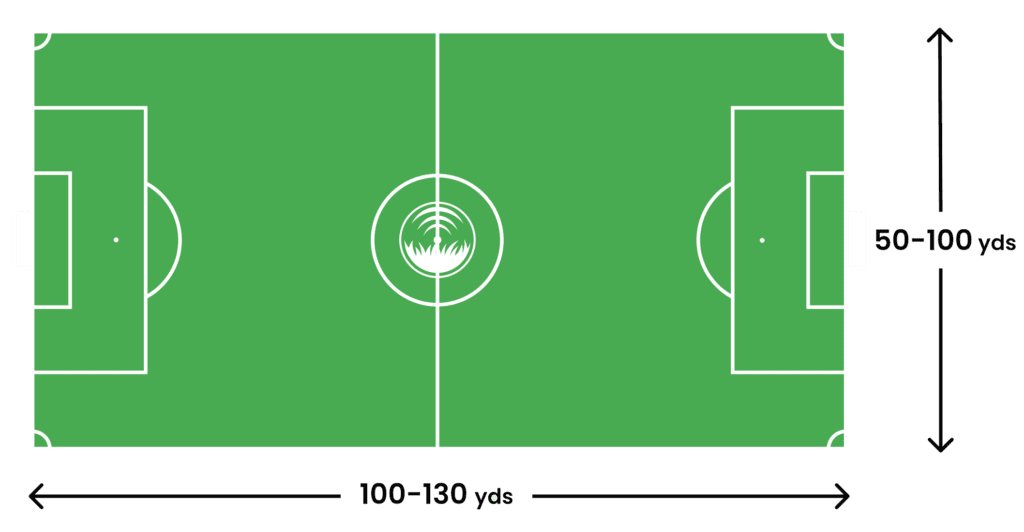
Spectator Areas: Distance And Safety
When you cheer for your favorite team, you think about the players and the game. But, the place where you sit matters a lot too! Let’s talk about where fans watch the game. It is safe and fun.
Buffer Zones Around The Field
Safety first when it comes to enjoying a soccer match! Around the soccer field, there’s an area called buffer zone. It keeps the fans away from the players. This way, everyone stays safe. These zones are usually at least 5 meters wide. But, they can change based on the size of the stadium.
- Players have space – they can run and kick without worry.
- Fans get a clear view – they can see the game without nets or fences in the way.
Stadium Capacity And Viewing Angles
Stadiums can be big or small. But, how many people they can fit changes. Stadium capacity decides how many fans can watch live. We measure viewing angles from where fans sit. It helps to see the game without straining necks.
| Stadium Size | Capacity | Best Viewing Angles |
|---|---|---|
| Small | Up to 10,000 seats | 30° to 50° |
| Medium | 10,000 to 20,000 seats | 100° to 120° |
| Big | Over 20,000 seats | Up to 160° |
A bigger stadium needs screens. Then fans at the back can see too. Seats need good angles. The ball looks round, not like an egg!
Regulatory Bodies And Field Standards
Understanding Regulatory Bodies and Field Standards is key for soccer clubs, players, and fans alike. Soccer field dimensions may vary. Yet, they all adhere to guidelines set by regulatory bodies. These standards ensure fair play across different levels of the game worldwide.
Fifa’s Role In Field Dimensions
FIFA is the global soccer authority. They dictate the official size for professional fields. A FIFA-regulated field must be 100-110 meters long. It must also be 64-75 meters wide. These measurements ensure a consistent playing experience everywhere.
Here’s a quick look at FIFA’s requirements:
| Field Part | Minimum Size | Maximum Size |
|---|---|---|
| Length | 100 meters | 110 meters |
| Width | 64 meters | 75 meters |
| Goal Area | 18 meters box | |
Adaptations For Youth And Amateur Soccer
Not all soccer is played on full-sized fields. Youth and amateur leagues often use smaller fields. This is to accommodate the players’ age and skill levels. Smaller fields allow youth to enjoy the game, without feeling overwhelmed. Fields’ sizes are modified, based on player age groups.
- U6 – 18 x 30 meters
- U8 – 30 x 50 meters
- U10 – 45 x 70 meters
- U12 – 50 x 80 meters
- U14 and above – approach full-sized regulations
These adaptions help make the game fun and safe. Kids learn and grow with the sport, enjoying every match.
Impact Of Field Size On Playing Styles
The size of a soccer field deeply influences how the game flows. Teams must adapt their playing styles to fit within the lines that define the field’s length and width. Smaller fields demand quick thinking and rapid play. Larger fields allow for more strategic approaches, with players having the space to orchestrate long passes and spread out the defense. Understanding field size is crucial for both teams and players alike, shaping the game into an unpredictable dance of tactics and physical prowess.
Strategy Adjustments For Different Sizes
Soccer coaches face the challenge of adjusting their strategies based on field dimensions. A larger field may lead to strategies that exploit the wings. Players can make long passes and crosses. In contrast, a small field may focus on quick passes. Coaches often tweak formations to best use the field size. This might mean deploying more midfielders for control on a compact pitch. Or it could involve using fast wingers to maximize space on a larger one. Teams must adapt to control the game’s flow, regardless of field size.
Physical Demand And Team Formation
The physical demand of a soccer match often correlates with the size of the field. A large pitch requires greater endurance and speed. Players cover more ground and must maintain a high level of fitness. Coaches might choose formations that support endurance in these conditions. An example is the 4-3-3 formation, which provides balance and width. On a smaller field, the focus could shift to technical ability and positioning. The common 4-4-2 formation allows for compact defense and efficient use of space. These tactical decisions are critical for success on varied pitch sizes.
Technological Innovations In Field Design
The size of the soccer field is not just about dimensions. Today, technology shapes the play area. Innovations make fields smarter and games better. Let’s dive into how technology changes field design.
Drainage Systems And Underfield Heating
Rain can stop play. But not with modern drainage systems. These systems keep fields dry and playable. They work in rains and storms. The fields are always ready for a game.
Winters bring cold and snow. Soccer does not pause for snow. Underfield heating systems keep the field warm. No snow or ice can stay on the heated pitch. Games continue in cold weather.
Smart Turf And Performance Metrics
Smart turf is the future in soccer fields. It collects data. Every step and turn players take on the field gets tracked. Coaches and players use this information. They improve tactics and training.
- Data Sensors: In the turf, sensors measure performance.
- Real-Time Analysis: Coaches get live feedback on player actions.
- Injury Prevention: Data can help predict and prevent injuries.
Players perform their best on smart fields. Fans enjoy a high-quality game. Soccer fields have become high-tech arenas.
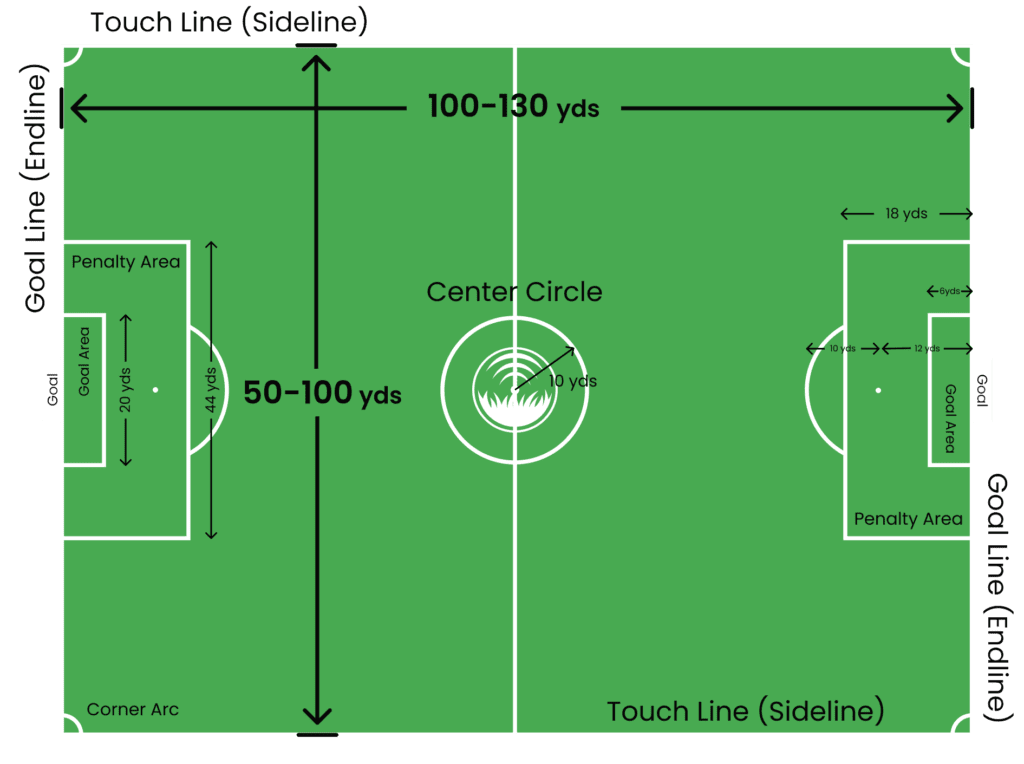
Historical Changes And Their Reasons
The size of a soccer field has evolved over time. Many wonder why these changes occurred. In the past, there were no set rules for field dimensions. Through time, the need for a standard playing area became essential for fair play. This led to the establishment of regulations that shape modern soccer.
Evolution Of Soccer Field Standards
Soccer fields have changed much since the game began. Originally, fields varied greatly in size. Games became hard to compare or standardize. In 1863, the first rules for field size were set. The guidelines have been updated as soccer grew. The current standards allow for a level playing field worldwide.
| Year | Field Length Range (yards) | Field Width Range (yards) |
|---|---|---|
| 1863 | 100 – 200 | 50 – 100 |
| Today | 110 – 120 | 70 – 80 |
Note: These specs ensure games are fair and familiar.
Influence Of Historical Games On Modern Rules
Historical games shaped today’s soccer field size. Early football games, like cujus ludus in Rome, used no fields. Later, towns played on open space, with no fixed size. These games influenced how soccer rules developed. They showed the need for fixed sizes. This brought about rules that control the dimensions of modern soccer fields.
- Folk football: No prescribed field size.
- Public schools: Different sizes led to set measurements.
- FIFA: Now enforces field size rules.

Frequently Asked Questions Of Size Of Soccer Field
What is the standard size of a soccer field?
A standard soccer field measures between 100 and 130 yards in length and 50 to 100 yards in width. Professional matches often use fields closer to 115 yards by 74 yards.
Are youth soccer sield dimensions different?
Yes, youth soccer fields are smaller. Dimensions vary by age group but typically range from 15-25 yards in width to 25-35 yards in length for the youngest players, increasing with age.
How does soccer field size affect gameplay?
A larger field offers more space, affecting player stamina, team tactics, and the game’s pace. Smaller fields can lead to a faster, more compact game, emphasizing technical skills.
What’s the size of a world Cup Soccer field?
World Cup soccer fields comply with FIFA’s regulations, maintaining a length of 110-120 yards and a width of 70-80 yards. These dimensions ensure a consistent playing experience across matches.
Conclusion
Understanding the size of a soccer field is crucial for players, coaches, and fans alike. It affects strategy, conditioning, and the game’s flow. Remember, regulations may vary by league and age group, so always check specific guidelines. Embrace the dimensions’ role in the beautiful game’s excitement and complexity.
 Cric Enjoy Sports News, Cricket Update, Live Streaming
Cric Enjoy Sports News, Cricket Update, Live Streaming
